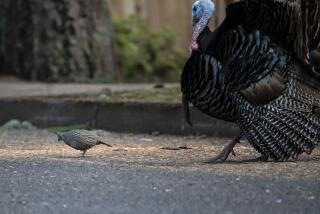Op-Ed: For scientists like me, good research isn’t enough. We have to tell our stories
Ornithology conferences aren’t typically of interest to anyone but ornithologists. We spend days cooped up in meetings, listening to speakers, staring at graphs and tables, and attempting to digest research on bird physiology, migration and genetics.
But last year, on a late June evening in Anchorage, we did something else as well — something scientists too often overlook. At an event modeled on “The Moth” radio show, participants from the American Ornithological Society’s annual meeting were allotted seven minutes each to tell a story, with the loose theme being, as you might have guessed, birds.
One of the first tales featured the nuances of birdsong among golden-crowned sparrows, chunky, fist-sized birds with distinctive facial markings that can be found in California during the winter. In the summer, they nest in open habitats of Alaska and western Canada.
Their sweet, simple song is easily recognized and, as a result, is often one of the first that beginning birders add to their repertoires. It consists of three long, descending notes best described through the mnemonic, “Oh dear me…” At first listen, there’s not much to it. Sometimes a bird stutters, stopping mid-song only to pick up again with the next verse. But the basic pattern remains the same, repeated again and again. What many people don’t know, however, is that birds, like humans, have unique dialects that develop through generations of cultural evolution.
The scientist telling this story was Daizaburo Shizuka, a young researcher who immigrated to the United States from Japan as a 7-year-old child, at the tail end of what’s known as the “critical period” for language acquisition. He explained that birds learn their songs through a process similar to how we learn language. Like us, they also have critical acquisition periods early in their lives; as a result, they sing the songs of their natal origin — in other words, a bird speaks the language of its homeland.
Shizuka studied a mixed-dialect population of golden-crowned sparrows that breed in the mountains near Whitehorse, in Canada’s Yukon. Although the territories of these birds sometimes overlap, each bird sings just one dialect in its life. Except, he explained to us, one exceptional bird. This lone male could sing two dialects perfectly — an avian version of being bilingual. He roamed across a large area, singing his extraordinary songs.
Shizuka took special note of this individual, which he could identify by the unique arrangement of color bands on its legs and its distinctive voice. As an ornithologist specializing in avian vocalizations, Shizuka was attuned to the subtleties that might appear on a spectrogram of birdsong. As an immigrant, he could relate to the experience of isolation through language.
Shizuka had no discernible accent. Still, he explained, sounding the same as everyone else doesn’t necessarily equate to feeling the same. Even though he had arrived in the U.S. just in time to catch the critical language acquisition period, the rest of his family hadn’t. He told us how he had witnessed his older brothers’ inability to perceive the nuances of English and his parents’ struggle to adapt. Often serving as translator, he felt their embarrassment and alienation as his own.
As the season progressed, the bilingual bird continued to roam. He visited one territory and then another. He sang and sang, rendering perfect notes from both dialects. But every time the researchers saw him, he was alone. Despite his unique talents, or perhaps because of them, he never found a mate. Eventually, while all the other birds were busy raising their young, he stopped singing. One day, he simply disappeared.
Shizuka told us how he hoped the bird had found his home, somewhere over the mountain. He, too, understood the challenges of occupying two worlds at once. He felt the burden of being different. And through the story of this unusual bird, singing its lonely heart out, so could we all.
Do most of us care whether a sparrow sings “Oh deeee-ar me” or “Or dear meeeee”? Probably not. Can we all relate, in some capacity, to the feeling of being ostracized or excluded? Of course. Can we learn by example how curiosity and connection lead to scientific discovery? There’s no better precursor to knowledge. Through the simple act of storytelling, we can help cultivate both scientific literacy and empathy.
The ordinary way for Shizuka to share his research would have been to describe his observations of birdsong, draw conclusions about the different populations he observed and leave it at that. The bilingual bird would have been considered an outlier, and ignored. Instead, by sharing its unique story, and its relevance to our own experiences, Shizuka taught us something about birdsong, but also so much more. In that moment, we remembered what it meant to be both scientists and humans.
In this time of scientific apathy and social divisiveness, we can no longer afford to treat narrative as the antithesis of knowledge. To be good scientists, we need not be emotionless robots. Instead, we have an obligation to add storytelling to our resumes as statisticians, ecologists, naturalists, physiologists, mathematicians and geneticists. By sharing experiences, we expand our collective understanding — about science and about one another. We begin to appreciate how a seemingly minute difference in a three-note birdsong might matter to all of us.
Caroline Van Hemert is a wildlife biologist in Alaska and author of “The Sun Is a Compass: A 4,000-mile Journey into the Alaskan Wilds.”
More to Read
A cure for the common opinion
Get thought-provoking perspectives with our weekly newsletter.
You may occasionally receive promotional content from the Los Angeles Times.










